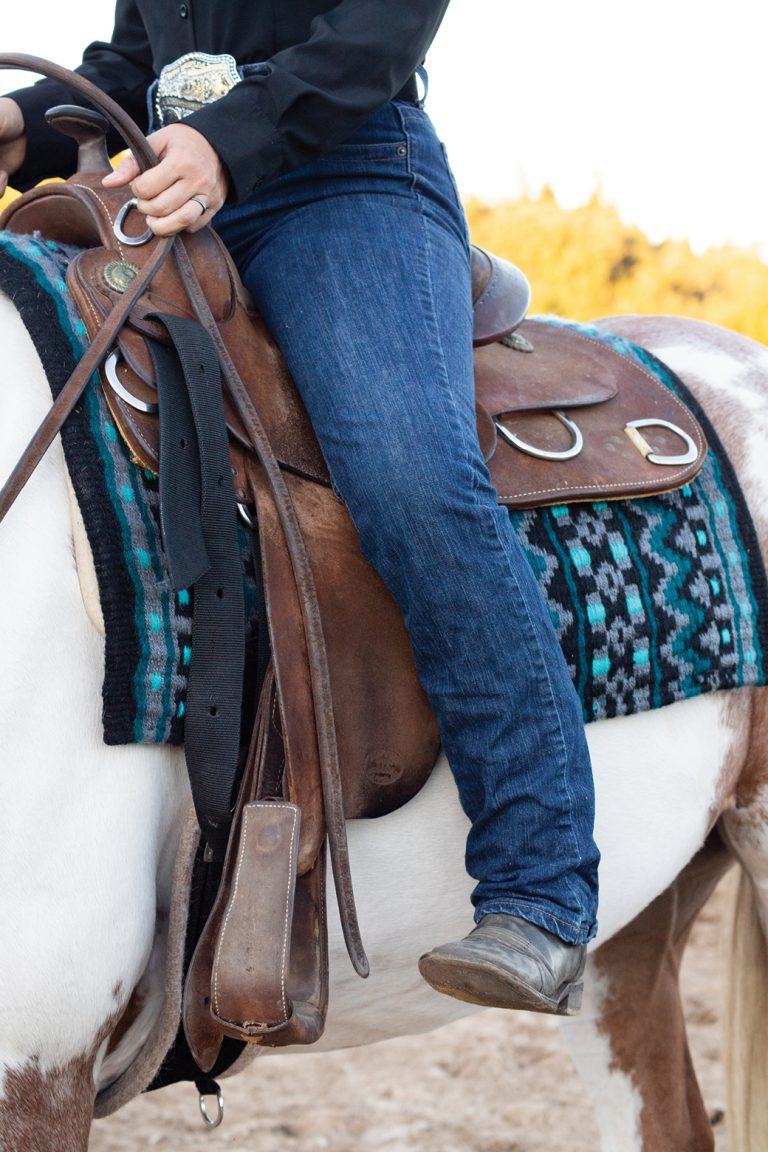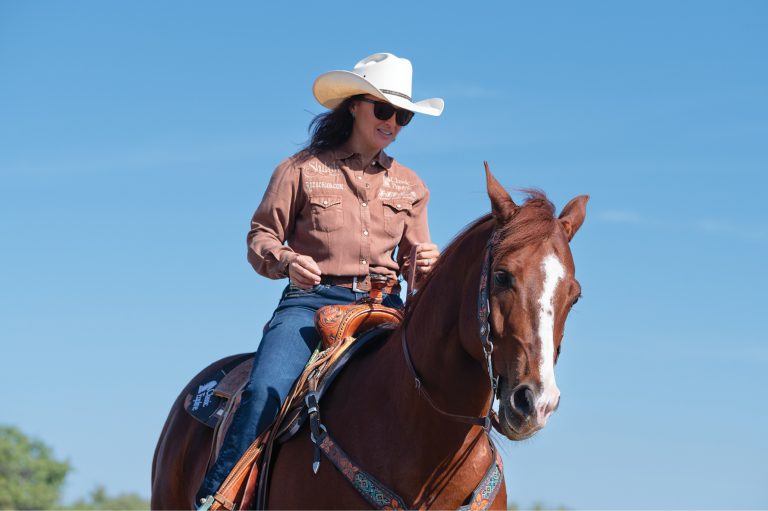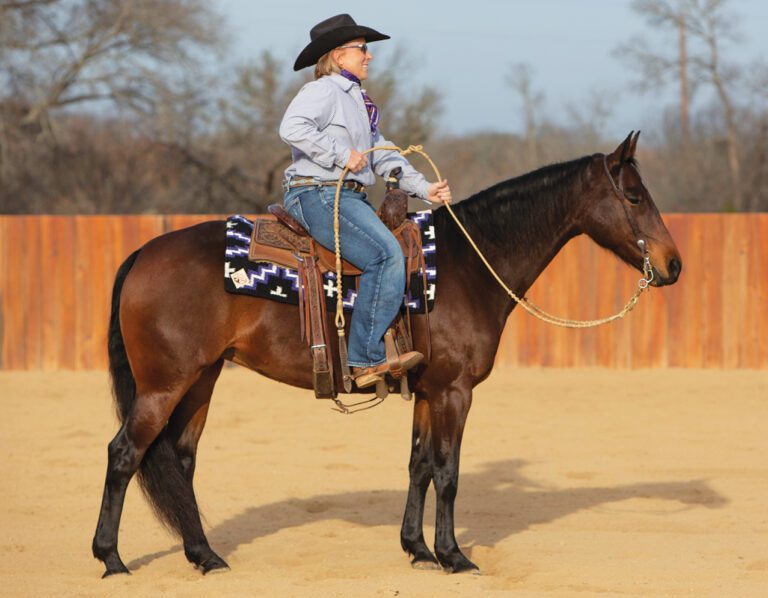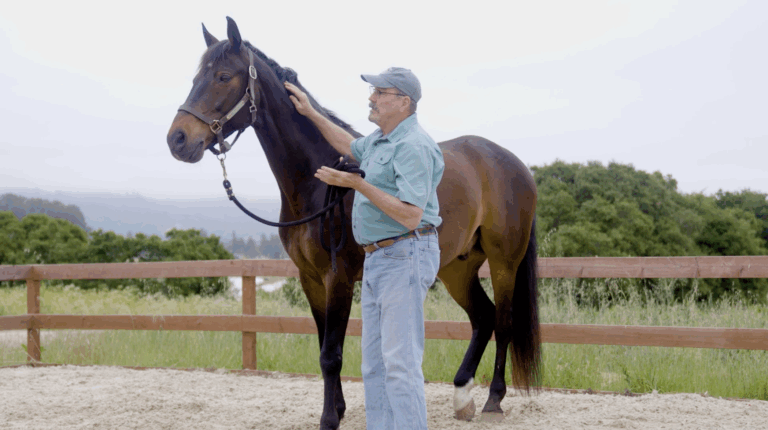
Q I’ve been showing for a few years and compete in several classes in the novice division at local Quarter Horse shows with my gelding. When we show in rail classes he’s fine, but I’ve noticed that when we’re doing pattern events—like horsemanship—he gets extremely nervous standing at the cone and it continues through the pattern. I’d like to complete a pattern without him tensing up as we approach the cone. What can I do at home and at horse shows to help him become more comfortable alone in the arena?
ALYSSA WRIGHT, Iowa
A Your horse is naturally a herd animal, so it’s not surprising that he’d rather be with other horses than in the middle of the arena by himself. But when you compete in pattern events like the horsemanship, trail, Western riding, or reining, you and your horse must be comfortable riding a pattern alone in the arena. As a judge and exhibitor, I’ve seen and dealt with horses that suffer from separation anxiety. However, I’ve also seen a lot of riders unintentionally create these problems with their horse as they walk to the start cone.
Here I’ll discuss a few reasons why your horse might be nervous when you approach the start of your pattern and explain what you can do to help him when you’re at home or at a horse show.
Work on Yourself
[READ: A Calm Horse Learns Best]
While your horse could be genuinely anxious when he leaves the lineup to go to the middle of the pen by himself, it’s important to look at what you’re doing when you leave the lineup. When you approach the start cone, it’s easy to become nervous—especially if you’re a rookie in pattern events—and your horse recognizes your nerves.
The start of the pattern dictates the rest of your ride. If you’re fidgety before you begin, your horse feeds off your nervous energy. You’ll then be up against it for the entirety of your ride. When you become nervous, your body tenses up, and your horse feel’s a difference in your body language, including how you cue him. This causes him to become tense and change the way he responds to you.
Eliminate the shuffle: When I’m judging a horsemanship class, I notice some riders like to do what I call the “shuffle.” This means as you approach the cone, you’re moving your body around, adjusting your upper body and leg. You might catch yourself bumping on your horse’s head or unintentionally jabbing him with your spur to get his attention as you approach or stand at the cone to begin your pattern.
Your horse doesn’t understand why you only do this when you go into the show arena. If you automatically start jabbing your spurs into his sides or bumping on his face every time you walk to that cone, he’s going to associate it with getting in trouble. He doesn’t understand why you’re punishing him every time you walk to the cone, and eventually he starts dancing around, trying to figure out what you want.
Be prepared: Imagine a scenario where you walk to the cone on a draped rein, no contact with your horse, and stare at the judge, completely forgetting about what your horse is doing. Then when time comes to start your pattern, you kick him forward and try to get his back rounded up, and his head in the bridle as you’re maneuvering through a pattern.
The lack of preparedness at the cone throws your horse off guard, and just like when you constantly bump his face when you’re walking to the cone, eventually he’s going to get nervous if you go from no contact to a full kick forward every time you start your pattern.
The fix: Before you work on getting your horse to relax at the cone, make sure you’re riding form to function. Don’t change the way you ride when you’re showing. Support him with your leg as you walk to the cone, keep contact with your hand, and keep him in the bridle. This helps him focus on you as you wait to start your pattern.
When you’re showing, be aware of how long the pattern is. Don’t arrive at the cone too soon before it’s your turn and start bumping on your horse’s face because he’s lost focus. On the other hand, don’t be late getting to the cone so you must rush. That can cause both you and your horse to become nervous before you even begin your ride. Give yourself enough time to be at the start cone so you’re ready to go when the judge looks your direction.
[READ: Calm Your Horse Naturally]

Work on Your Horse
If your horse does have anxiety leaving a group of horses to go into the arena, spend time both at home and at horse shows riding alone to build up his confidence.
At home: Ride in the arena when there are no other horses to distract him. If you keep your horse at home, it might be easier to find a time to ride without anyone else in the arena. But if you keep your horse at a boarding barn, try to choose a time when there are fewer or no other riders in the arena.
As nice as it is to ride your horse next to your friends, it’s important that your horse gets comfortable at home without any other horses around him. Build his confidence at home so when you get to the horse show he’s already more comfortable riding around by himself.
Set up a few cones in your arena to help you practice the start of your pattern. When you walk up to it, keep your leg on your horse and have steady contact with your hand to help him stay rounded up and in the bridle. If your horse isn’t round when you start your pattern, you can’t expect him to be round when you ask for a walk, trot, or lope. Make sure he stands still and relaxed. Be patient the first time you work with him. You might do more standing than moving until he realizes that you’re not going to move your body around or bump on his face.
At the show: It can take a lot of horse showing before your horse gets more comfortable in the show pen by himself. If you only attend a few shows a year, it might take longer to build his confidence compared to someone who has the opportunity to show every weekend.
[READ: How to Calm a Hot Horse]
Some horse shows keep arenas open all night, which is ideal for working on this problem, but is not always an option. Pick a time to ride when there are fewer riders in the arena. Practice standing quietly alone. Place a cone in the arena if you can, walk up to it, and stop. Keep your horse’s attention, but don’t pick at him. Instead let him relax and find assurance that he’s safe on his own, especially with his attention on you. Patience will be key to overcome his anxiety. Frustration will only exacerbate the problem; remain calm and be a confident leader for your horse. n
Jeff Mellott, Greeley, Colorado, is an AQHA and NSBA judge, and currently works as an associate trainer for T&L Quarter Horses with Tom and Leslie Lange. As a professional, Jeff has coached and trained multiple all-around riders and their horses to world championships and All American Quarter Horse Congress titles.




